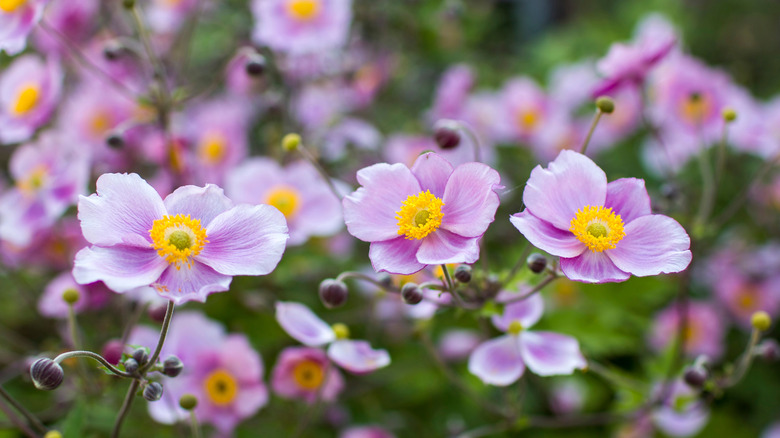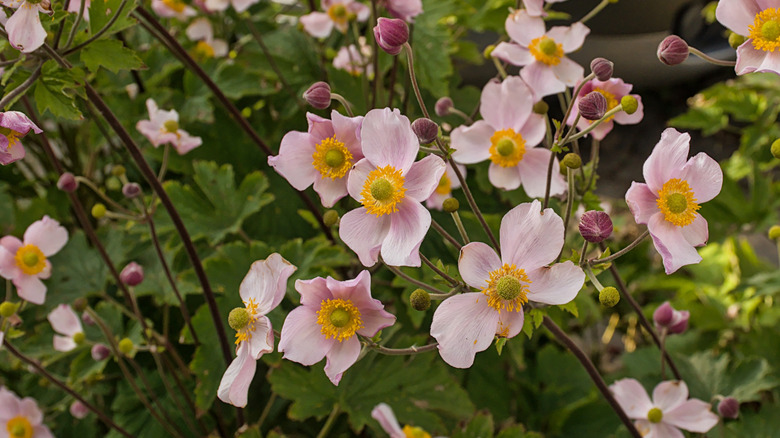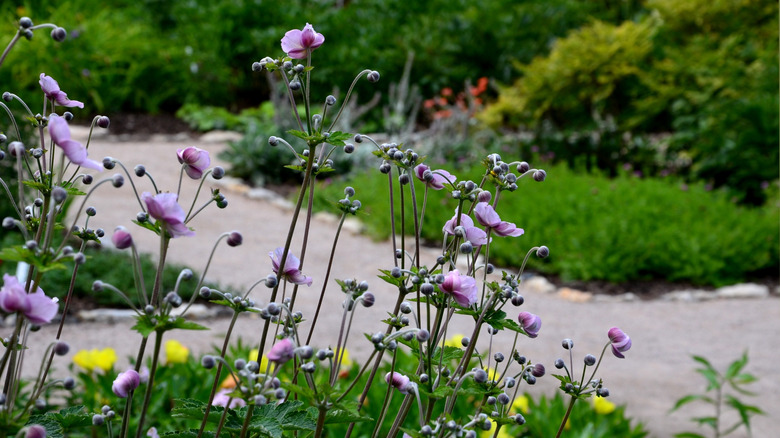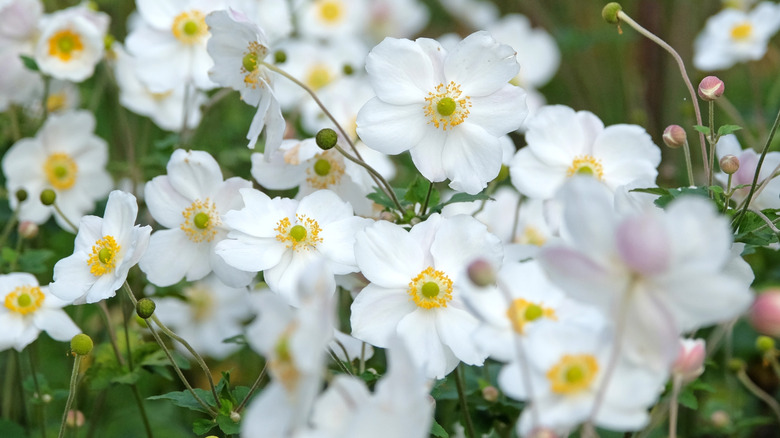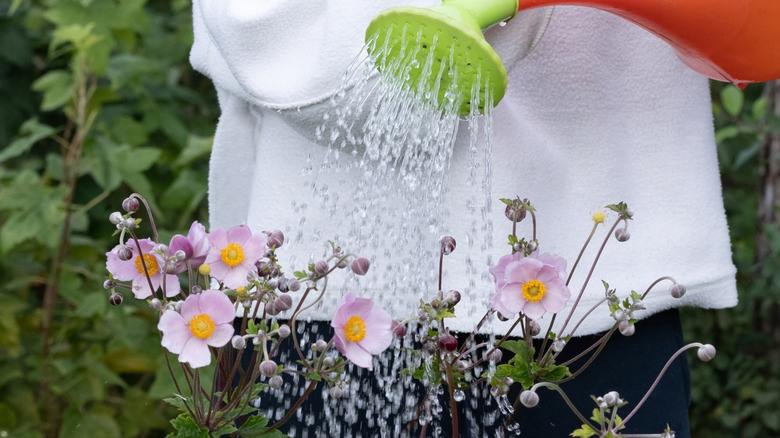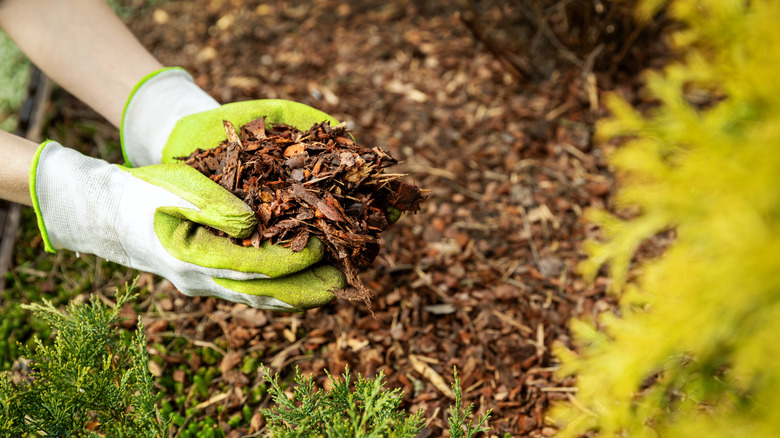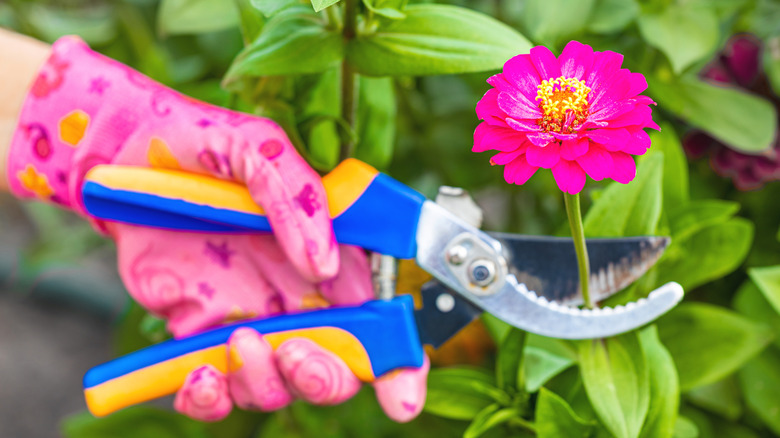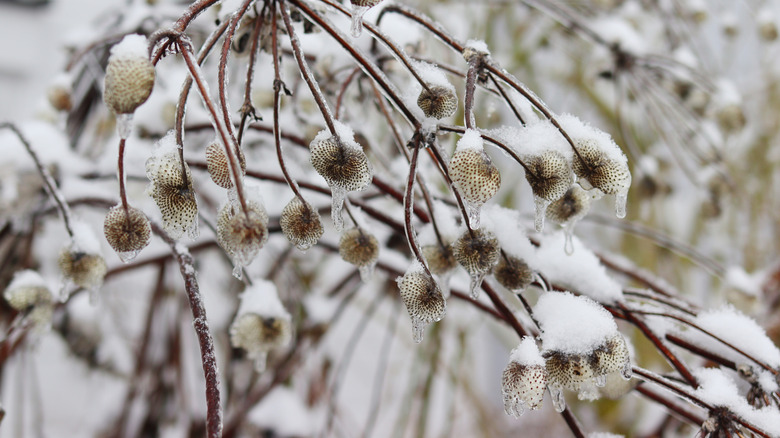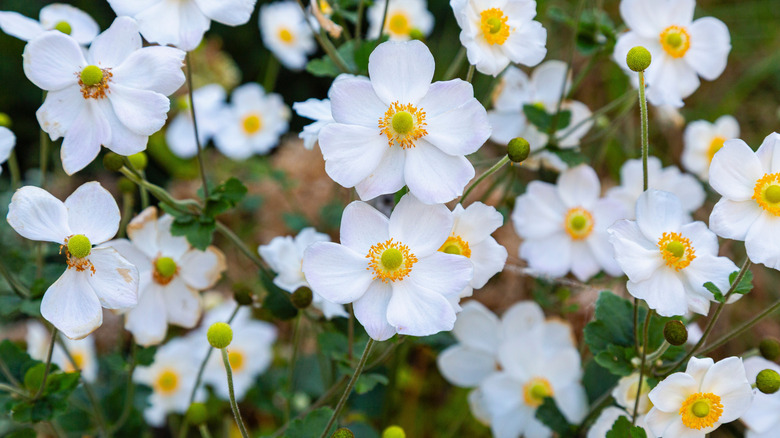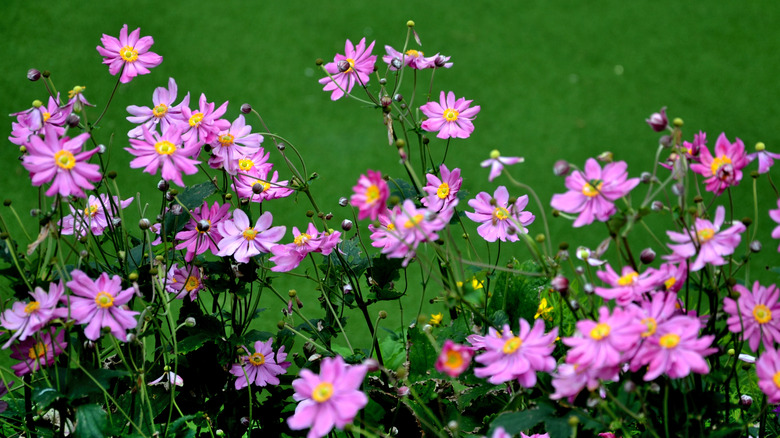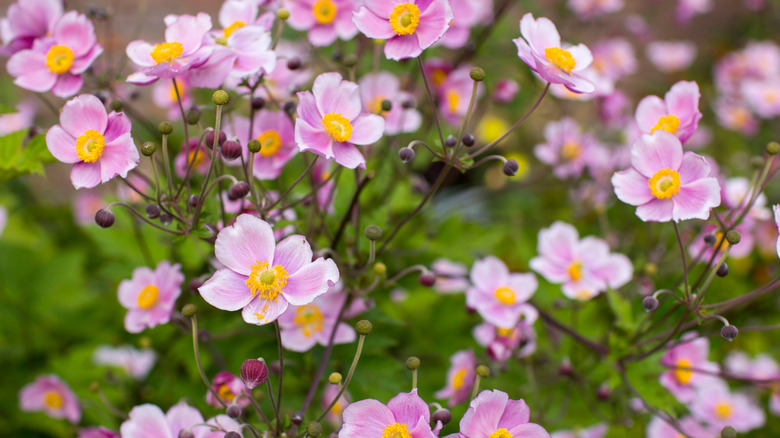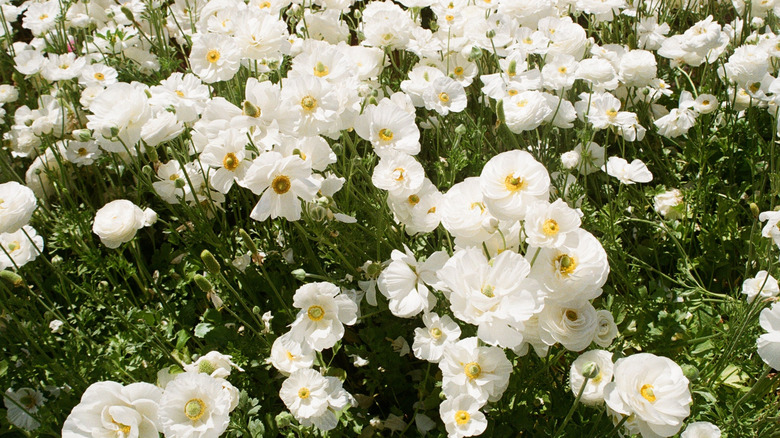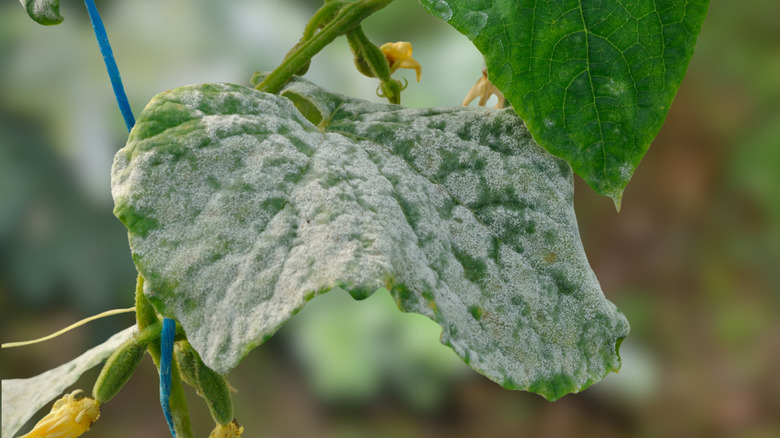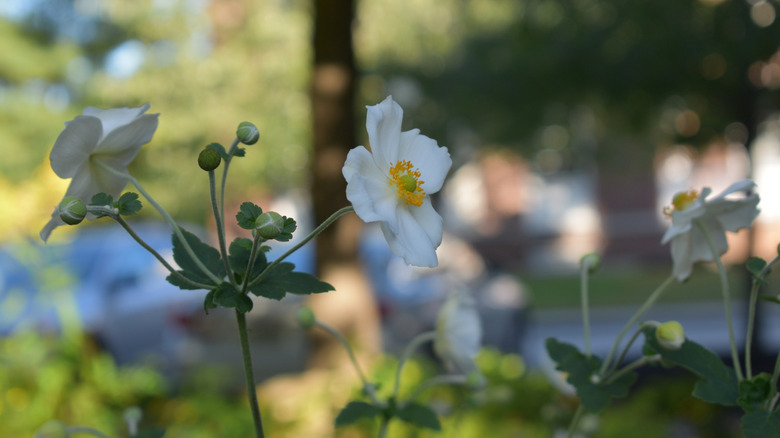15 Helpful Tips To Help Your Japanese Anemones Grow Strong (And In The Right Place)
We may receive a commission on purchases made from links.
Japanese anemones (Eriocapitella hybrids and E. hupehensis) have simple pink or white flowers with a golden center on tall, wiry stems. They bloom from late summer well into fall, and bring color and form when many other plants have already died back. Most reach between 2 and 5 feet at maturity, depending on cultivar, light, and soil, so plan for a mid-to-back-of-border role, where they can sway and spread without shading low growers. They do best in dappled shade or morning sun with afternoon shade, and can tolerate more sun where the soil stays evenly moist. Give them fertile, moisture-retentive, but well-drained, soil to avoid stress and weak bloom.
As a permaculture gardener, I appreciate Japanese anemones for their resistance to slugs, deer, and rabbit, as it's a constant battle to find things these critters will leave alone. Plus, they're great plants for attracting pollinators. Do plan for spread, though, as these plants expand by underground suckering roots, and some also self-seed, though many named hybrids set few viable seeds. Treat them as assertive perennials, which means you need to space them generously, set up containment where needed, and edge runners before they root into neighbors, so they enrich, rather than overrun, your planting.
Pick the right light
Aim for partial shade or bright, dappled light to keep stems sturdy and flowers coming without heat stress. Full sun can work in cooler regions or where soil stays evenly moist. But if the bed dries out, you'll see scorched leaves and a shorter bloom window. Be aware that deep shade often leads to taller, laxer growth that flops after rain, especially in rich soil.
Morning sun with afternoon shade is a safe default for most gardens. Track the light in your garden across a full day before planting. If stems lean toward the brightest side, thin or lift neighboring plants, or slide the clump a foot or two into a brighter patch to balance growth. In hot zones, avoid reflective heat from south-facing walls and paving, mulch to retain moisture and keep roots cool, and water at the base so foliage stays dry and less prone to mildew.
Aim for rich, moisture-retentive, well-drained soil
Plant these late-blooming herbaceous perennials in moist, but well-draining and fertile ground. It shouldn't be soggy, but shouldn't be excessively dry, either. Japanese anemones are also a great plant choice for rain gardens, because they like moist conditions and a lot of rainfall — as long as the soil there doesn't stay woggy and waterlogged for extended periods.
Work several inches of compost in across the whole bed, not just the planting hole, to improve both water retention and drainage, so roots stay cool and active through summer and autumn without suffocating. On clay, add plenty of rough organic matter to improve soil structure and drainage, and consider planting on a slight rise to help excess water run off. On very sandy soils, add compost and leaf mold to slow drying and stabilize nutrients, and consider creating a mulch berm to help retain moisture. After planting, mulch 1 to 2 inches with compost, well-rotted manure, or shredded leaves to steady moisture and feed gently. It's best to keep mulch just off the crowns to prevent rot and allow spring shoots to emerge cleanly.
Plant anemones in spring or autumn
Plant when soil is workable and moisture is reliable. Spring and autumn are ideal because cool air and mild, damp soil help the roots of your anemones settle and anchor in without heat stress. In colder climates, aim for autumn planting 4 to 6 weeks before the first hard frost, so roots can knit in before the ground freezes. If you want to plant in spring, wait until the soil no longer clings to your tools and isn't waterlogged, which can suffocate the crowns.
Whenever you plant, water in well and keep the soil evenly moist through the first season. If you're starting with small plugs, pot them up for a few weeks to build stronger roots, then plant out before they become rootbound in the pots. Shade new transplants during a hot spell to prevent wilt and leaf scorch, and avoid heavy feeding in the first month, so the plant prioritizes strong root growth, rather than top growth.
Give them space to spread
Japanese anemones expand by underground runners called rhizomes, and in rich, moist soil they can move steadily beyond the original clump once they get established. In leaner or heavier soils, though, they don't spread as fast. Space standard cultivars 2 to 3 feet apart to allow each plant to fill out without smothering one another.
In mixed borders, site them in the middle or back so their airy stems rise above shorter plants without shading them out. Make a clean line with an edging spade once or twice a season. Basically, you slice off outward runners before they root and produce new crowns — but make sure you lift what you sever and dispose of it or pot it up for elsewhere. If you want a controlled spread, point runners into open ground and let them knit a colony where their spread won't become a maintenance headache.
Use containers or cultivar pots to control spread
If your border is tight or you simply don't want runners slipping under prized perennials, grow compact Japanese anemones in roomy containers. Compact cultivars include 'Jasmine', 'little princess', and 'Red riding hood'. Growing in pots keep rhizomes contained, while still giving months of late-season color and pollinator food. Pick shorter named forms flagged for pots, such as 'pretty Lady Diana', bred for sturdier stems and a smaller footprint, and use a free-draining, moisture-retentive peat-free mix, so plants stay evenly moist without sitting wet.
Choose a large pot with drainage holes, water when the top inch begins to dry, and mulch the surface to slow evaporation during hot spells. In colder regions, cluster containers in a sheltered nook for winter, so repeated freeze–thaw doesn't heave the root ball. If flowers seem sparse, resist heavy feeding, especially in the first two seasons. While these plants do spread, they can be slow to get established, and during the first couple of seasons, the plant puts more energy into root growth than producing blooms. Repot them every couple of years to refresh the potting mix and lightly root-prune, which keeps container plants compact and productive.
Water new plants regularly, then only in dry spells
New transplants need consistent moisture through their first season to help them get established. Keep the root zone evenly moist, not soggy, and water at the base so foliage stays dry and less prone to mildew. A slow soak is better than frequent light sprinkles, because it drives water deeper and encourages roots to chase it, which builds drought resilience once plants are established. After the first year, most clumps in decent soil only need help during prolonged dry conditions, especially if you mulch each spring to help with moisture retention.
Water in the morning on hot days so the leaves can dry quickly, which further reduces disease risk. When watering, do it gently from the base, perhaps with a soaker hose, to avoid blasting soil splashes onto foliage, since splashing can move infected soil onto foliage where disease can take hold. If plants flag in the heat, rig up shade cloth for a week or two to help them recover.
Mulch each spring
Mulching in spring protects the root zone against heat stress, and retains moisture. Plus, the organic matter you mulch with slowly breaks down into the soil to release nutrients and improve soil health. For Japanese anemones, a 1 to 2-inch layer of compost or well-rotted manure in spring feeds slowly as it breaks down, conserves moisture, and smothers many weed seedlings. In hotter or windy beds, top the compost with a thicker organic mulch, such as shredded bark, to buffer heat and slow evaporation. Also, keep all mulch a couple of inches off crowns to prevent rot.
On lighter soils, mulching also insulates against freeze–thaw cycles that can cause frost heave for shallow roots. Refresh thin spots after heavy rain and re-edge the bed line so mulch doesn't creep into paths. Pair mulch with bed-wide composting during planting and you'll stabilize moisture and structure, which Japanese anemones reward with longer blooming and less stress.
Deadhead diligently to limit self-seeding
If you don't want surprise seedlings popping up, remove dead flowers before seed ripen. Species like E. hupehensis can self-seed where conditions suit, but most hybrids don't produce fertile or viable seed. So, if you're growing a hybrid cultivar, you can leave the seed head to feed the birds.
Deadheading also redirects energy to the roots and next year's shoots, which helps clumps bulk up. If you garden for wildlife, leave some decorative seedheads through winter for structure and occasional food, then cut the stems before spring growth pokes through, so you can cleanly rake and remulch without issues.
Cut back in early spring, not autumn, unless spread is your priority
Leaving the top growth over winter provides cover for insects and birds, hides and protects bare soil, and helps catch insulating snow. You'll usually get the best result by cutting stems back in early spring as buds swell, then clearing mulch gaps around crowns so new shoots aren't smothered. If your top priority is limiting spread and self-sown volunteers, you can clear the stems soon after flowering and pair that with steady deadheading to reduce seed set.
Always remove and bin any foliage marked by mildew or other disease, rather than composting it, to keep spores out of next year's growth. Avoid cutting on waterlogged days, as you'll risk compacting the soil as you walk on it to access the plants. Re-edge the clump after you finish cleanup, so runners don't slip into the neighboring plants once growth resumes.
Divide or reduce clumps every three to four years
Crowded clumps flower less and push harder into neighboring beds. Once every three to four years, divide the clumps, preferably in early spring, as shoots appear. You can also do this in early autumn while soil is still warm and moist, avoiding heat waves and frozen, waterlogged ground. Dividing clumps gives the plants a kind of reset. You'll reduce their footprint and get healthier, more vigorous plants with more flowers. However, remember that you've given those plants quite a shock, so they can take a full year to recover.
Loosen the soil in a wide circle with a fork, lift the clump, and pry it apart (or cut with a sharp knife) into several fat, healthy pieces. Discard woody centers and any weak, stringy growth. Replant divisions into improved soil at the original depth, water in well, and mulch. Treat them exactly as you would new plants, because, essentially, they are. If your aim is containment, don't replant every fragment you lift. Instead, pot spares or dispose of them, and re-edge the bed line so runners don't sneak outward again.
Propagate by root cuttings
Japanese anemones are easy to propagate from root cuttings. Take cuttings in late autumn to winter when plants are heading for dormancy. Don't lift the plant though. Instead, you want to find the rhizomes (runners) that are slowly spreading outward from the parent plant. These are the parts that you dispose of when you edge your anemones for containment. Look for thick, healthy-looking runners and take 2 to 3-inch segments. Set them horizontally in free-draining potting mix, cover lightly and keep them just moist, not wet.
Label every pot so these assertive growers don't end up in delicate beds by accident. Keep trays cool, but frost-free, to encourage callus and new buds. All of those little nodules along the rhizome are full of life, just waiting to put out a whole new plant. Very quickly, you'll have plenty of brand new anemone shoots, and ideally a bunch of plantable starts by late spring. When potting on, handle them gently, as young shoots can snap. And be sure to provide bright light and steady moisture. This method preserves cultivar traits, as rhizomes produce clones of their parent plants. Plus, it's generally faster than waiting for divisions to bulk up and recover.
Limit spread by planning for containment
In fluffy, moisture-rich soil, anemone's suckering roots can travel fast, which is great for naturalized drifts and wildflower gardens. But if you have tight borders or you don't want them to take over, then light, organic soil is not the best. In firmer, slightly heavier soils, these herbaceous perennials are slower to spread, giving you more control.
Now, I'm not suggesting you starve the bed, because anemones need fertile ground to thrive, but do go easy on repeated deep digging that over-loosens the soil structure, and avoid constant heavy irrigation that keeps soil spongy. If your soil is already very friable, then you may need to edge the anemones more frequently and be a bit more vigorous with your seasonal reduction or divisions.
The key here is to really build containment in from day one, because you know they'll spread. In beds, sink a vertical root barrier (stiff edging or HDPE) 10 to 12 inches deep around a planting pocket to stop outward runners, and pair it with twice-a-season edging to slice off any shoots that manage to breach the line.
Choose vigorous, but reliable, cultivars (and use shorter forms in tight spots)
Cultivar choice is important with Japanese anemones, because there are so many of them with a wide range of properties. Height, habit, spread, and disease-resistance are all determined by the cultivar you choose. Tall classics like 'Honorine Jobert' are great for a bright, back-of-border anchor that grows up to 4 feet in the right conditions, so give them space and light.
Medium picks, such as 'September Charm' (soft pink), suit the middle, where they won't swamp shorter front-of-border selections. In tight beds or for container growing, choose compact cultivars like those from the 'Pretty Lady' series. These are bred for shorter stems and a smaller footprint, which hold up better in wind and are easier to contain.
Watch out for powdery mildew and act fast if you spot it
Powdery mildew is a real pain, as it can infect plants rapidly and cause stunting and irregular growth. It looks like white dust on leaves and shoots. It spreads quickly, particularly when days are warm, nights are cool, and air is still — especially if foliage stays dry, while roots swing between wet and dry. This fungal pathogen can spread through the air and from cross-contamination. Tools, for example, used on infected plants and then used on healthy plants, without being cleaned, can spread the spores, as can your gardening gloves. Frustratingly, pollinators and other insects can also carry spores between plants. This is why it's so important to act fast if you spot any signs of this disease. Unfortunately, no mildew-resistant cultivars currently exist, but 'Honorine Jobert,' 'Pamina,' 'Wild Swan,' 'Robustissima,' and 'Fantasy™ Pocahontas' are all considered reliable, vigorous, healthful choices.
Start with prevention: Space plants for good airflow, thin nearby crowding, and water at the base, so you don't splash spores onto leaves. Keeping soil evenly moist and generally healthy makes them less stressed and therefore less prone to infection. At the first sign of powdery mildew, remove marked leaves and bin them. You can also burn them in a burn barrel, but you need to do it away from other at-risk plants, because some spores may escape thanks to their airborne nature. Once you've removed all diseased plant matter, clean your tools with 70% isopropyl alcohol, like Rapid Protectant's 70% Isopropyl Alcohol Spray, and run your gardening gloves through the washing machine.
Avoid heavy nitrogen that encourages too much soft growth, especially in fall, and water in the morning so any incidental splashes dry quickly. If mildew recurs every year, choose a breezier site and keep the crown clear of dense neighbors. Thin the plants and the bed in general to allow air to circulate and reduce warm, damp conditions. In severe seasons, labeled low-impact options (such as sulfur or horticultural oils, such as Monterey Horticultural Oil) can help when used according to directions and only on healthy, unstressed foliage.
Plant where wind isn't extreme
Japanese anemones carry blooms on tall, wiry stems that sway beautifully, but harsh wind can shred petals and topple fresh growth. Position them with light shelter, such as in the lee of a shrub line, a permeable fence, or a mixed planting that breaks gusts without creating a wind tunnel. Morning sun with afternoon shade in a semi-sheltered spot maximizes flowering season and reduces plant stress.
In exposed gardens, pick compact cultivars that carry flowers lower, or give tall clumps discreet support, such as a single ring or a few twiggy branches pushed in early so foliage grows through them. For containers, set pots where they won't catch the full brunt of prevailing winds and weight them with a broad, heavy container so they don't rock.
